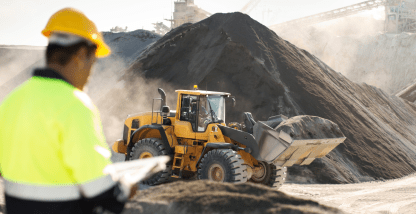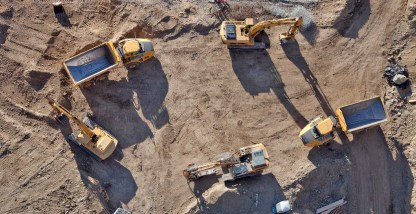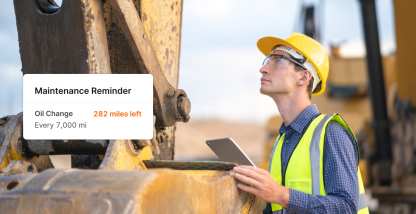A priority for every fleet manager should be managing risk in construction projects. Risks to a construction company’s fleet of vehicles and equipment can come in various forms, including operational expenses, driver safety, and equipment and vehicle maintenance.
Risk management in construction projects can minimize the impact of adverse events and keep the project running smoothly. Let’s take a closer look at what construction risk management is and how to maintain risk management as a fleet manager with the latest technology.
What is construction risk management?
Construction risk management is the process of evaluating and implementing procedures to reduce the impact of risks in construction projects. Risk analysis in construction involves thorough planning that allows fleet managers to identify, monitor, and mitigate risks as they arise.
There’s a lot to consider when creating a comprehensive risk management plan. Make sure you’re considering the various areas of a complex construction project that could produce risk.
Are there different types of risk in construction?
For those in construction looking to implement a successful risk management strategy, knowing where you’re vulnerable to risk is key. You must be aware of anything and everything that could be potentially harmful to the success of your projects.
There can be many types of risks in construction. In general, risk is anything that will delay the project or create further costs. There are many components to manage. These can include heavy equipment, contractors working in precarious situations, complicated logistics, and safety hazards.
To create a risk management plan, it’s essential to know the different areas in which risk can occur.
Safety
A report from the U.S. Bureau of Labor found that fatal work injuries in construction and extraction companies increased by 6% in 2019. As you know, construction is inherently risky. And your crew is your most valuable resource. Nothing can be done without them. They’re also subject to safety hazards, because many of their tasks can be dangerous. These hazards can result in overexertion, illness, equipment accidents, and, in some cases, fatalities.
Legal
There are legal risks. These can include regulations, code violations, and contract terms disputes with your clients, vendors, and subcontractors. Any of these constraints can send your construction project off track. This area of risk exposure can delay projects and increase costs.
Financial
Often the result of a lack of proper planning, financial risks can lead to cash shortages that can slow projects down, or stop them completely. When project delays and stops happen, legal risk can also be at play when contracts aren’t fulfilled in time. While this isn’t typically the first risk that springs to mind when it comes to construction projects, it’s a vital risk to be aware of.
Environmental
Environmental risks can’t be avoided. These types of risks are events such as floods, earthquakes, and other kinds of natural disasters that are an ever-present threat. These environmental risks can make work inaccessible and slow down project progress. Another potential harmful result of inclement weather is the risk of damage to machinery or materials, which inevitably delays projects and adversely affects operations.
Project
Project risks are universal project management risks associated with managing any project. When trying to effectively manage project risks, 66% of contractors report that they have challenges. Any risks that negatively impact overall project performance put the entire project at risk of failure. This catch-all category involves risk areas such as:
- General delays
- Poor project oversight
- Lack of communication
- Problems with scheduling
- Conflicts within the team
Understanding contractor risk management in construction
Today, contractors are often used to complete construction work. Because hiring contractors is common managers might assume that it comes with relatively low risk. This isn’t always the case.
Contracted companies or workers aren’t always prepared to limit project risks. So, be sure to carefully vet potential contractors before working with them. If those in construction risk management don’t put enough thought into how to prevent common problems caused by contractors, they expose themselves to potential project delays and financial losses.
Accidents on the job, work delays, low-quality work, lack of warranty, and going over budget are just some of the risks that hiring companies assume when working with contractors.
As a manager in construction who oversees risk management, it’s impossible to have a contractor assume all of the risks that come with performing what can be dangerous work. Ultimately, responsibility falls on the company that’s running the project. Some hiring companies might want to pass costs from risk incident fines or extensive equipment repairs onto contractors. But this isn’t possible very often.
There are a few things you can do to make sure you’re prepared for the risks that come along with hiring contractors for your construction projects:
- Prepare for possible risks throughout the entire contract period.
- Make sure you’re documenting the work contractors are doing.
- Spend time making a robust risk response plan.
How to undertake a construction risk analysis as a fleet manager
As a fleet manager looking to complete a risk analysis, there are a few steps you can take to make sure the process goes as smoothly as possible:
- Undertake a risk analysis
- First, you should identify any risks that are apparent to you as you begin the planning process. Begin identifying risks as soon as possible so you have as much time as you can to manage the risks that arise. Getting members of the team together to discuss potential risks is a good way to start the risk identification process. Look back at past projects and create a comprehensive list of all possible risks identified. Keep the list fluid, but make sure you create a cut-off time for this stage of the risk analysis process so you can make enough time for other stages.
- Organize risks in levels of importance
- Not all risks are equal. Some are more likely to occur. Others less so. You should categorize risks based on a few things: to what extent the potential risk will impact your business, and the likelihood of the potential risk happening. Use data where you can to help find the answers. Risks that have a higher chance of occurring, and that have a big impact, should be handled first. Other lower priority risks can be taken care of once the big items are handled.
- Create a plan and strategy
- Creating a plan and strategy for risk management should be the next thing you tackle. Your plan needs to be robust and include how you’ll respond to incidents and who will be responsible for each task included in your response plan. Your plan should also prioritize each risk from high to low, and include information on which resources will be needed to effectively mitigate the risk.
- Put the plan in place
- This is where you implement a contingency plan that will reduce the likelihood and impact of the risks you identified earlier. The top priority, of course, is those you defined as highly likely and having the greatest impact. Here are a few things to keep in mind as you work to finalize your plan:
- Software is your friend. For risks when it comes to your vehicle and equipment fleet, software like Motive can help you ensure drivers are safe on the road and vehicles are always properly maintained.
- Software that automatically alerts you of risks can be a huge asset as you begin to handle larger and more complex projects.
- Make sure that members of your team are involved when you’re starting to put your plan into place. Risk management isn’t a solo activity, but a team effort. Make sure all action items and dependencies in your plan have clear owners. Share your plan with crew members and stakeholders so everyone is on the same page. And be sure to take into account the operating procedures and priorities of different team functions.
- This is where you implement a contingency plan that will reduce the likelihood and impact of the risks you identified earlier. The top priority, of course, is those you defined as highly likely and having the greatest impact. Here are a few things to keep in mind as you work to finalize your plan:
How to cut down risk with Motive
Motive’s fleet and equipment management platform helps construction companies get visibility into their business, automate manual work, reduce operational costs, and be safer. Motive offers a variety of benefits to fleet managers in construction looking to implement a comprehensive risk management plan. These benefits include:
- Finding equipment faster. With GPS tracking, Motive allows you to know the exact location of all vehicles and equipment at all times. No more wasting time with phone calls, job site checks, or yard checks.
- Recovering stolen assets. GPS tracking capabilities can also help construction companies mitigate financial risks by being able to locate and track down missing or stolen equipment and vehicles.
- Yard and job-site inventory. With drag-and-drop geofencing capabilities, fleet managers can get a real-time list of which assets are at a given site, and ensure that no unauthorized vehicles are entering your geofenced area.
- Faster, more accurate billing. For construction companies that bill customers based on the time certain equipment stays on a job site, geofencing and asset tracking capabilities automatically track the time each asset is on a given job site.
- Efficient management of equipment and vehicle inventory. With utilization reporting, fleet managers can proactively identify types of equipment that may become a shortage in the future, redeploy underutilized equipment to existing job sites, and sell underutilized equipment or vehicles.
- Fleet safety and driver coaching. Motive’s dashcams and fleet safety solution can help fleet managers increase driver safety and improve driver performance to help prevent accidents on the way to and from job sites.
- Stay on top of vehicle and asset maintenance. Get ahead of maintenance issues with Motive’s automated scheduling reminders. And catch defects early with fault code detection and real-time alerts.
- Visibility into fuel consumption. Reduce fuel costs with visibility into wasteful driver behaviors — including over RPM, hard braking, and average driving speed — so you know exactly where to focus coaching efforts.
- Uplevel your customer service. Create exceptional experiences by keeping customers in the loop with real-time tracking and delivery alerts.
To learn more about how you can use Motive as part of your comprehensive construction risk management plan, request a demo.









